CNC:MH 92446: Collaborative Mental Health Nursing Practice Essay
VerifiedAdded on 2022/11/17
|8
|2768
|3
Essay
AI Summary
This essay provides a detailed analysis of collaborative mental health nursing practices in Australia, focusing on the crucial nurse-consumer relationship and the impact of mental disorders. It explores the significance of nurses understanding patients' lived experiences and the role of the Mental Health Services Act (MHSA). The essay examines key terms like 'collaborative nurse-consumer relationship' and the 'lived experiences of mental disorder,' emphasizing the need for improved healthcare collaboration. It discusses the detrimental effects of mental illness, stigma, and discrimination on patients, and the importance of effective communication, counseling, and rehabilitation. Furthermore, it identifies the need for nurses to develop specific skills and attitudes to enhance collaborative practices, ultimately aiming to improve patient outcomes and promote a more supportive healthcare environment. The essay also provides real-life experiences and examples that illustrate the practical applications of collaborative nursing practices.
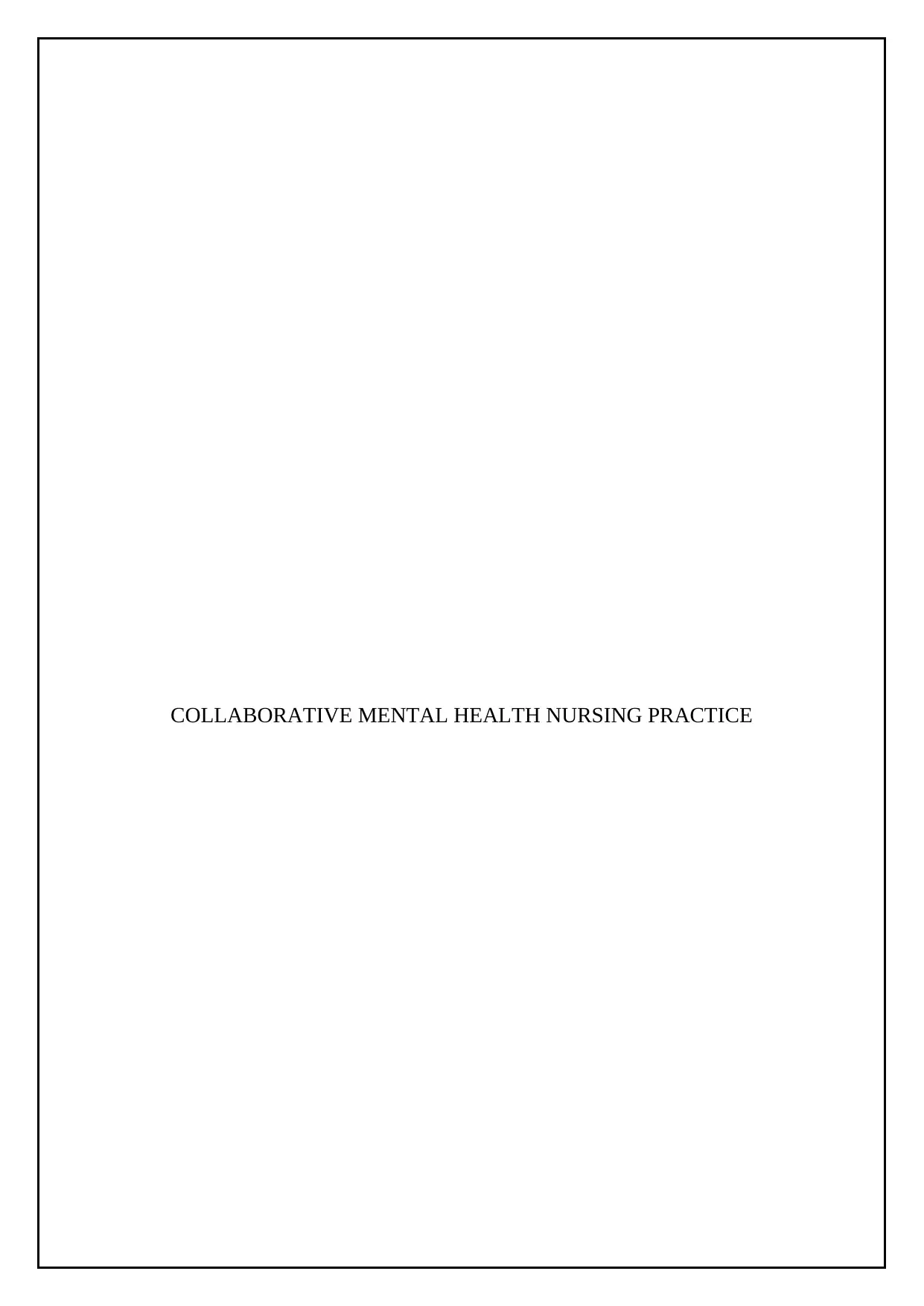
COLLABORATIVE MENTAL HEALTH NURSING PRACTICE
Paraphrase This Document
Need a fresh take? Get an instant paraphrase of this document with our AI Paraphraser
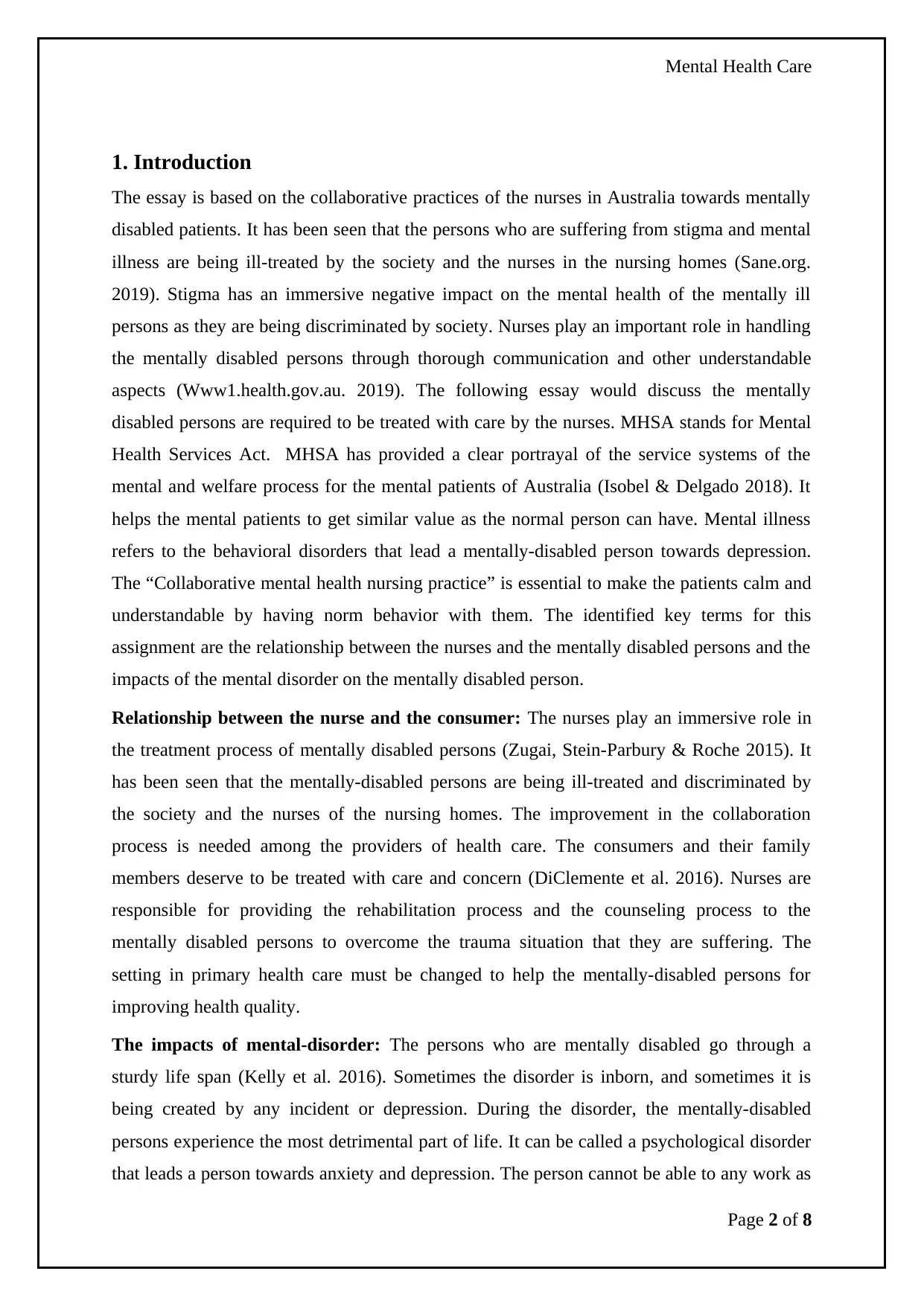
Mental Health Care
1. Introduction
The essay is based on the collaborative practices of the nurses in Australia towards mentally
disabled patients. It has been seen that the persons who are suffering from stigma and mental
illness are being ill-treated by the society and the nurses in the nursing homes (Sane.org.
2019). Stigma has an immersive negative impact on the mental health of the mentally ill
persons as they are being discriminated by society. Nurses play an important role in handling
the mentally disabled persons through thorough communication and other understandable
aspects (Www1.health.gov.au. 2019). The following essay would discuss the mentally
disabled persons are required to be treated with care by the nurses. MHSA stands for Mental
Health Services Act. MHSA has provided a clear portrayal of the service systems of the
mental and welfare process for the mental patients of Australia (Isobel & Delgado 2018). It
helps the mental patients to get similar value as the normal person can have. Mental illness
refers to the behavioral disorders that lead a mentally-disabled person towards depression.
The “Collaborative mental health nursing practice” is essential to make the patients calm and
understandable by having norm behavior with them. The identified key terms for this
assignment are the relationship between the nurses and the mentally disabled persons and the
impacts of the mental disorder on the mentally disabled person.
Relationship between the nurse and the consumer: The nurses play an immersive role in
the treatment process of mentally disabled persons (Zugai, Stein-Parbury & Roche 2015). It
has been seen that the mentally-disabled persons are being ill-treated and discriminated by
the society and the nurses of the nursing homes. The improvement in the collaboration
process is needed among the providers of health care. The consumers and their family
members deserve to be treated with care and concern (DiClemente et al. 2016). Nurses are
responsible for providing the rehabilitation process and the counseling process to the
mentally disabled persons to overcome the trauma situation that they are suffering. The
setting in primary health care must be changed to help the mentally-disabled persons for
improving health quality.
The impacts of mental-disorder: The persons who are mentally disabled go through a
sturdy life span (Kelly et al. 2016). Sometimes the disorder is inborn, and sometimes it is
being created by any incident or depression. During the disorder, the mentally-disabled
persons experience the most detrimental part of life. It can be called a psychological disorder
that leads a person towards anxiety and depression. The person cannot be able to any work as
Page 2 of 8
1. Introduction
The essay is based on the collaborative practices of the nurses in Australia towards mentally
disabled patients. It has been seen that the persons who are suffering from stigma and mental
illness are being ill-treated by the society and the nurses in the nursing homes (Sane.org.
2019). Stigma has an immersive negative impact on the mental health of the mentally ill
persons as they are being discriminated by society. Nurses play an important role in handling
the mentally disabled persons through thorough communication and other understandable
aspects (Www1.health.gov.au. 2019). The following essay would discuss the mentally
disabled persons are required to be treated with care by the nurses. MHSA stands for Mental
Health Services Act. MHSA has provided a clear portrayal of the service systems of the
mental and welfare process for the mental patients of Australia (Isobel & Delgado 2018). It
helps the mental patients to get similar value as the normal person can have. Mental illness
refers to the behavioral disorders that lead a mentally-disabled person towards depression.
The “Collaborative mental health nursing practice” is essential to make the patients calm and
understandable by having norm behavior with them. The identified key terms for this
assignment are the relationship between the nurses and the mentally disabled persons and the
impacts of the mental disorder on the mentally disabled person.
Relationship between the nurse and the consumer: The nurses play an immersive role in
the treatment process of mentally disabled persons (Zugai, Stein-Parbury & Roche 2015). It
has been seen that the mentally-disabled persons are being ill-treated and discriminated by
the society and the nurses of the nursing homes. The improvement in the collaboration
process is needed among the providers of health care. The consumers and their family
members deserve to be treated with care and concern (DiClemente et al. 2016). Nurses are
responsible for providing the rehabilitation process and the counseling process to the
mentally disabled persons to overcome the trauma situation that they are suffering. The
setting in primary health care must be changed to help the mentally-disabled persons for
improving health quality.
The impacts of mental-disorder: The persons who are mentally disabled go through a
sturdy life span (Kelly et al. 2016). Sometimes the disorder is inborn, and sometimes it is
being created by any incident or depression. During the disorder, the mentally-disabled
persons experience the most detrimental part of life. It can be called a psychological disorder
that leads a person towards anxiety and depression. The person cannot be able to any work as
Page 2 of 8
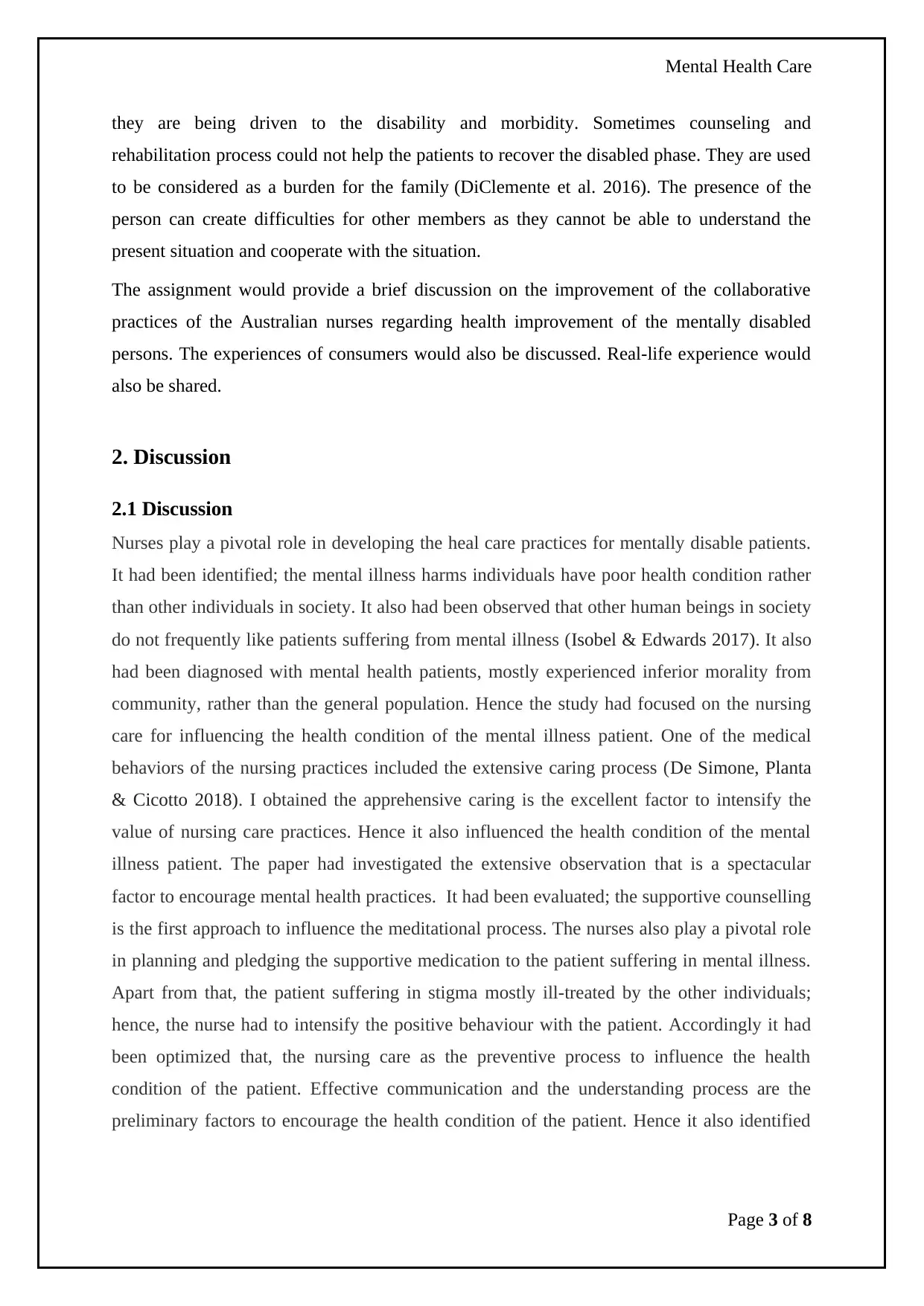
Mental Health Care
they are being driven to the disability and morbidity. Sometimes counseling and
rehabilitation process could not help the patients to recover the disabled phase. They are used
to be considered as a burden for the family (DiClemente et al. 2016). The presence of the
person can create difficulties for other members as they cannot be able to understand the
present situation and cooperate with the situation.
The assignment would provide a brief discussion on the improvement of the collaborative
practices of the Australian nurses regarding health improvement of the mentally disabled
persons. The experiences of consumers would also be discussed. Real-life experience would
also be shared.
2. Discussion
2.1 Discussion
Nurses play a pivotal role in developing the heal care practices for mentally disable patients.
It had been identified; the mental illness harms individuals have poor health condition rather
than other individuals in society. It also had been observed that other human beings in society
do not frequently like patients suffering from mental illness (Isobel & Edwards 2017). It also
had been diagnosed with mental health patients, mostly experienced inferior morality from
community, rather than the general population. Hence the study had focused on the nursing
care for influencing the health condition of the mental illness patient. One of the medical
behaviors of the nursing practices included the extensive caring process (De Simone, Planta
& Cicotto 2018). I obtained the apprehensive caring is the excellent factor to intensify the
value of nursing care practices. Hence it also influenced the health condition of the mental
illness patient. The paper had investigated the extensive observation that is a spectacular
factor to encourage mental health practices. It had been evaluated; the supportive counselling
is the first approach to influence the meditational process. The nurses also play a pivotal role
in planning and pledging the supportive medication to the patient suffering in mental illness.
Apart from that, the patient suffering in stigma mostly ill-treated by the other individuals;
hence, the nurse had to intensify the positive behaviour with the patient. Accordingly it had
been optimized that, the nursing care as the preventive process to influence the health
condition of the patient. Effective communication and the understanding process are the
preliminary factors to encourage the health condition of the patient. Hence it also identified
Page 3 of 8
they are being driven to the disability and morbidity. Sometimes counseling and
rehabilitation process could not help the patients to recover the disabled phase. They are used
to be considered as a burden for the family (DiClemente et al. 2016). The presence of the
person can create difficulties for other members as they cannot be able to understand the
present situation and cooperate with the situation.
The assignment would provide a brief discussion on the improvement of the collaborative
practices of the Australian nurses regarding health improvement of the mentally disabled
persons. The experiences of consumers would also be discussed. Real-life experience would
also be shared.
2. Discussion
2.1 Discussion
Nurses play a pivotal role in developing the heal care practices for mentally disable patients.
It had been identified; the mental illness harms individuals have poor health condition rather
than other individuals in society. It also had been observed that other human beings in society
do not frequently like patients suffering from mental illness (Isobel & Edwards 2017). It also
had been diagnosed with mental health patients, mostly experienced inferior morality from
community, rather than the general population. Hence the study had focused on the nursing
care for influencing the health condition of the mental illness patient. One of the medical
behaviors of the nursing practices included the extensive caring process (De Simone, Planta
& Cicotto 2018). I obtained the apprehensive caring is the excellent factor to intensify the
value of nursing care practices. Hence it also influenced the health condition of the mental
illness patient. The paper had investigated the extensive observation that is a spectacular
factor to encourage mental health practices. It had been evaluated; the supportive counselling
is the first approach to influence the meditational process. The nurses also play a pivotal role
in planning and pledging the supportive medication to the patient suffering in mental illness.
Apart from that, the patient suffering in stigma mostly ill-treated by the other individuals;
hence, the nurse had to intensify the positive behaviour with the patient. Accordingly it had
been optimized that, the nursing care as the preventive process to influence the health
condition of the patient. Effective communication and the understanding process are the
preliminary factors to encourage the health condition of the patient. Hence it also identified
Page 3 of 8
⊘ This is a preview!⊘
Do you want full access?
Subscribe today to unlock all pages.

Trusted by 1+ million students worldwide
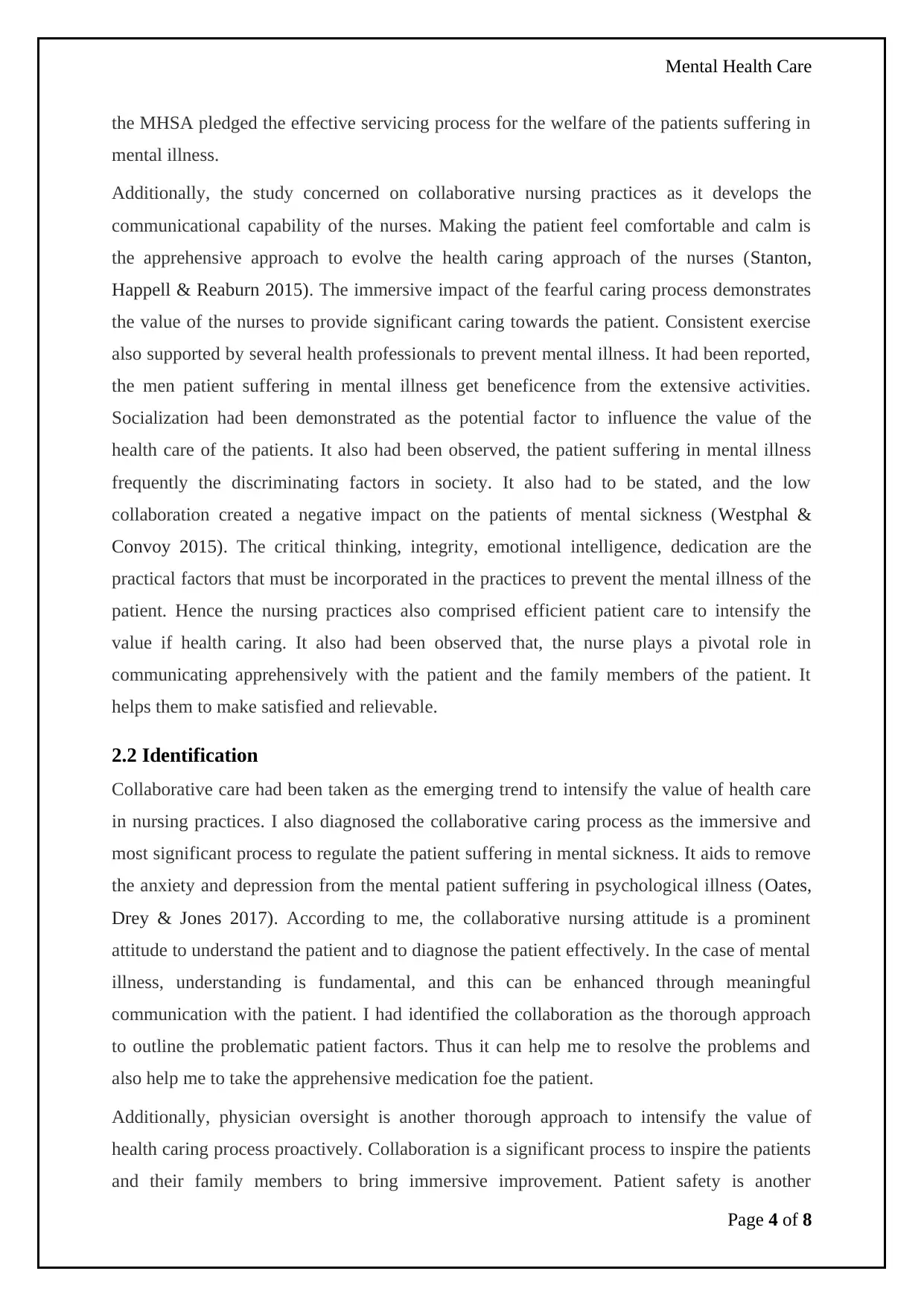
Mental Health Care
the MHSA pledged the effective servicing process for the welfare of the patients suffering in
mental illness.
Additionally, the study concerned on collaborative nursing practices as it develops the
communicational capability of the nurses. Making the patient feel comfortable and calm is
the apprehensive approach to evolve the health caring approach of the nurses (Stanton,
Happell & Reaburn 2015). The immersive impact of the fearful caring process demonstrates
the value of the nurses to provide significant caring towards the patient. Consistent exercise
also supported by several health professionals to prevent mental illness. It had been reported,
the men patient suffering in mental illness get beneficence from the extensive activities.
Socialization had been demonstrated as the potential factor to influence the value of the
health care of the patients. It also had been observed, the patient suffering in mental illness
frequently the discriminating factors in society. It also had to be stated, and the low
collaboration created a negative impact on the patients of mental sickness (Westphal &
Convoy 2015). The critical thinking, integrity, emotional intelligence, dedication are the
practical factors that must be incorporated in the practices to prevent the mental illness of the
patient. Hence the nursing practices also comprised efficient patient care to intensify the
value if health caring. It also had been observed that, the nurse plays a pivotal role in
communicating apprehensively with the patient and the family members of the patient. It
helps them to make satisfied and relievable.
2.2 Identification
Collaborative care had been taken as the emerging trend to intensify the value of health care
in nursing practices. I also diagnosed the collaborative caring process as the immersive and
most significant process to regulate the patient suffering in mental sickness. It aids to remove
the anxiety and depression from the mental patient suffering in psychological illness (Oates,
Drey & Jones 2017). According to me, the collaborative nursing attitude is a prominent
attitude to understand the patient and to diagnose the patient effectively. In the case of mental
illness, understanding is fundamental, and this can be enhanced through meaningful
communication with the patient. I had identified the collaboration as the thorough approach
to outline the problematic patient factors. Thus it can help me to resolve the problems and
also help me to take the apprehensive medication foe the patient.
Additionally, physician oversight is another thorough approach to intensify the value of
health caring process proactively. Collaboration is a significant process to inspire the patients
and their family members to bring immersive improvement. Patient safety is another
Page 4 of 8
the MHSA pledged the effective servicing process for the welfare of the patients suffering in
mental illness.
Additionally, the study concerned on collaborative nursing practices as it develops the
communicational capability of the nurses. Making the patient feel comfortable and calm is
the apprehensive approach to evolve the health caring approach of the nurses (Stanton,
Happell & Reaburn 2015). The immersive impact of the fearful caring process demonstrates
the value of the nurses to provide significant caring towards the patient. Consistent exercise
also supported by several health professionals to prevent mental illness. It had been reported,
the men patient suffering in mental illness get beneficence from the extensive activities.
Socialization had been demonstrated as the potential factor to influence the value of the
health care of the patients. It also had been observed, the patient suffering in mental illness
frequently the discriminating factors in society. It also had to be stated, and the low
collaboration created a negative impact on the patients of mental sickness (Westphal &
Convoy 2015). The critical thinking, integrity, emotional intelligence, dedication are the
practical factors that must be incorporated in the practices to prevent the mental illness of the
patient. Hence the nursing practices also comprised efficient patient care to intensify the
value if health caring. It also had been observed that, the nurse plays a pivotal role in
communicating apprehensively with the patient and the family members of the patient. It
helps them to make satisfied and relievable.
2.2 Identification
Collaborative care had been taken as the emerging trend to intensify the value of health care
in nursing practices. I also diagnosed the collaborative caring process as the immersive and
most significant process to regulate the patient suffering in mental sickness. It aids to remove
the anxiety and depression from the mental patient suffering in psychological illness (Oates,
Drey & Jones 2017). According to me, the collaborative nursing attitude is a prominent
attitude to understand the patient and to diagnose the patient effectively. In the case of mental
illness, understanding is fundamental, and this can be enhanced through meaningful
communication with the patient. I had identified the collaboration as the thorough approach
to outline the problematic patient factors. Thus it can help me to resolve the problems and
also help me to take the apprehensive medication foe the patient.
Additionally, physician oversight is another thorough approach to intensify the value of
health caring process proactively. Collaboration is a significant process to inspire the patients
and their family members to bring immersive improvement. Patient safety is another
Page 4 of 8
Paraphrase This Document
Need a fresh take? Get an instant paraphrase of this document with our AI Paraphraser
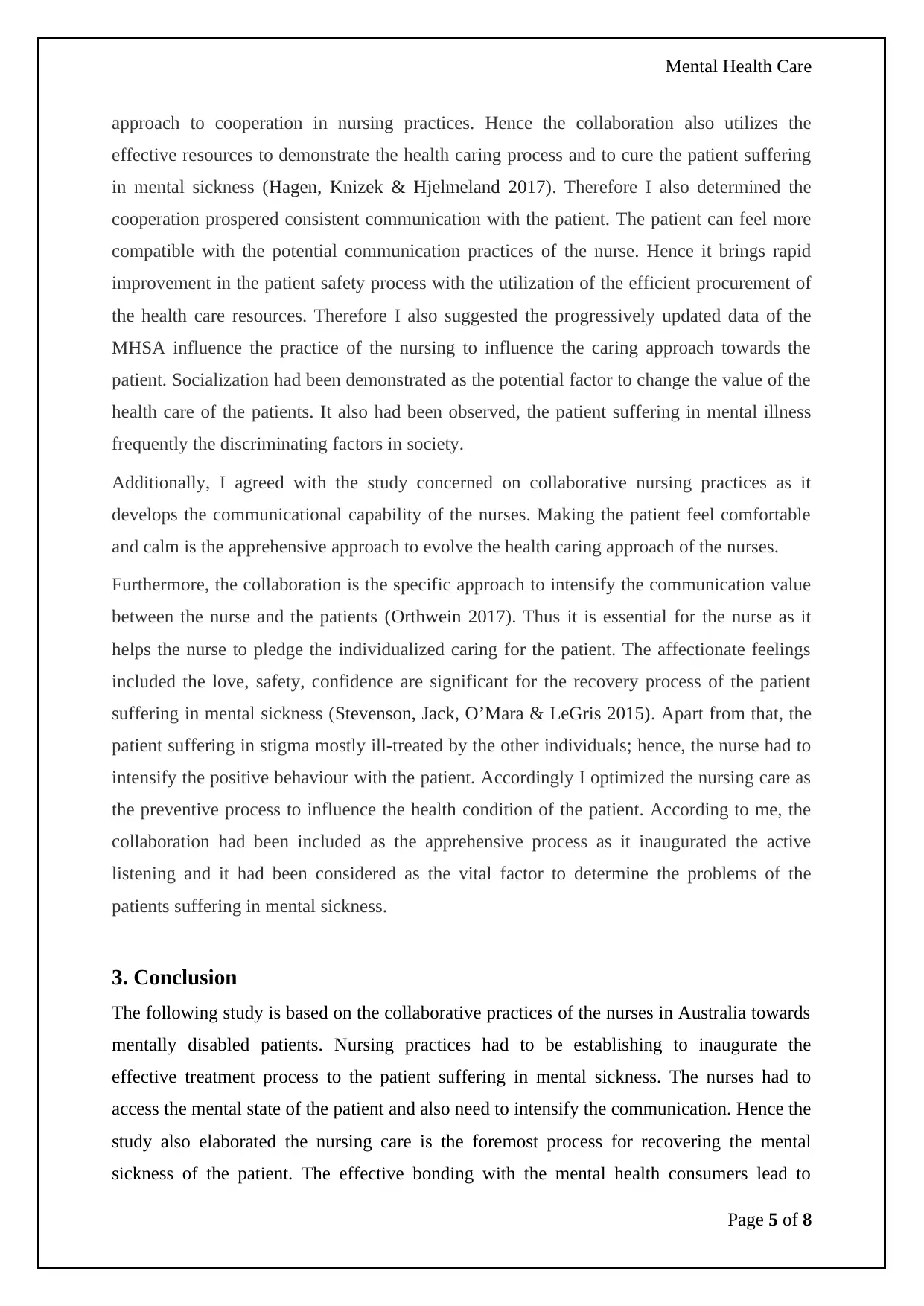
Mental Health Care
approach to cooperation in nursing practices. Hence the collaboration also utilizes the
effective resources to demonstrate the health caring process and to cure the patient suffering
in mental sickness (Hagen, Knizek & Hjelmeland 2017). Therefore I also determined the
cooperation prospered consistent communication with the patient. The patient can feel more
compatible with the potential communication practices of the nurse. Hence it brings rapid
improvement in the patient safety process with the utilization of the efficient procurement of
the health care resources. Therefore I also suggested the progressively updated data of the
MHSA influence the practice of the nursing to influence the caring approach towards the
patient. Socialization had been demonstrated as the potential factor to change the value of the
health care of the patients. It also had been observed, the patient suffering in mental illness
frequently the discriminating factors in society.
Additionally, I agreed with the study concerned on collaborative nursing practices as it
develops the communicational capability of the nurses. Making the patient feel comfortable
and calm is the apprehensive approach to evolve the health caring approach of the nurses.
Furthermore, the collaboration is the specific approach to intensify the communication value
between the nurse and the patients (Orthwein 2017). Thus it is essential for the nurse as it
helps the nurse to pledge the individualized caring for the patient. The affectionate feelings
included the love, safety, confidence are significant for the recovery process of the patient
suffering in mental sickness (Stevenson, Jack, O’Mara & LeGris 2015). Apart from that, the
patient suffering in stigma mostly ill-treated by the other individuals; hence, the nurse had to
intensify the positive behaviour with the patient. Accordingly I optimized the nursing care as
the preventive process to influence the health condition of the patient. According to me, the
collaboration had been included as the apprehensive process as it inaugurated the active
listening and it had been considered as the vital factor to determine the problems of the
patients suffering in mental sickness.
3. Conclusion
The following study is based on the collaborative practices of the nurses in Australia towards
mentally disabled patients. Nursing practices had to be establishing to inaugurate the
effective treatment process to the patient suffering in mental sickness. The nurses had to
access the mental state of the patient and also need to intensify the communication. Hence the
study also elaborated the nursing care is the foremost process for recovering the mental
sickness of the patient. The effective bonding with the mental health consumers lead to
Page 5 of 8
approach to cooperation in nursing practices. Hence the collaboration also utilizes the
effective resources to demonstrate the health caring process and to cure the patient suffering
in mental sickness (Hagen, Knizek & Hjelmeland 2017). Therefore I also determined the
cooperation prospered consistent communication with the patient. The patient can feel more
compatible with the potential communication practices of the nurse. Hence it brings rapid
improvement in the patient safety process with the utilization of the efficient procurement of
the health care resources. Therefore I also suggested the progressively updated data of the
MHSA influence the practice of the nursing to influence the caring approach towards the
patient. Socialization had been demonstrated as the potential factor to change the value of the
health care of the patients. It also had been observed, the patient suffering in mental illness
frequently the discriminating factors in society.
Additionally, I agreed with the study concerned on collaborative nursing practices as it
develops the communicational capability of the nurses. Making the patient feel comfortable
and calm is the apprehensive approach to evolve the health caring approach of the nurses.
Furthermore, the collaboration is the specific approach to intensify the communication value
between the nurse and the patients (Orthwein 2017). Thus it is essential for the nurse as it
helps the nurse to pledge the individualized caring for the patient. The affectionate feelings
included the love, safety, confidence are significant for the recovery process of the patient
suffering in mental sickness (Stevenson, Jack, O’Mara & LeGris 2015). Apart from that, the
patient suffering in stigma mostly ill-treated by the other individuals; hence, the nurse had to
intensify the positive behaviour with the patient. Accordingly I optimized the nursing care as
the preventive process to influence the health condition of the patient. According to me, the
collaboration had been included as the apprehensive process as it inaugurated the active
listening and it had been considered as the vital factor to determine the problems of the
patients suffering in mental sickness.
3. Conclusion
The following study is based on the collaborative practices of the nurses in Australia towards
mentally disabled patients. Nursing practices had to be establishing to inaugurate the
effective treatment process to the patient suffering in mental sickness. The nurses had to
access the mental state of the patient and also need to intensify the communication. Hence the
study also elaborated the nursing care is the foremost process for recovering the mental
sickness of the patient. The effective bonding with the mental health consumers lead to
Page 5 of 8
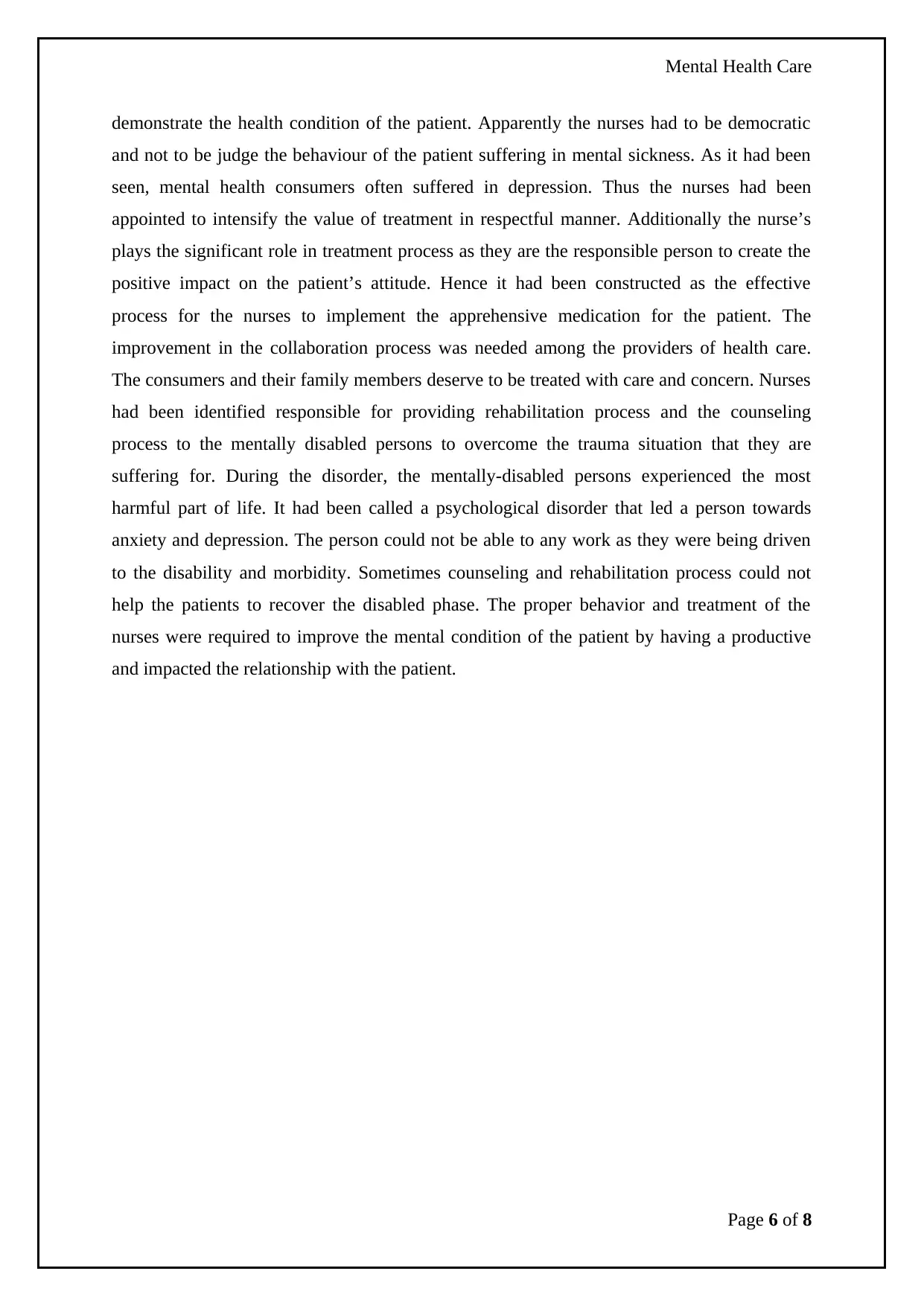
Mental Health Care
demonstrate the health condition of the patient. Apparently the nurses had to be democratic
and not to be judge the behaviour of the patient suffering in mental sickness. As it had been
seen, mental health consumers often suffered in depression. Thus the nurses had been
appointed to intensify the value of treatment in respectful manner. Additionally the nurse’s
plays the significant role in treatment process as they are the responsible person to create the
positive impact on the patient’s attitude. Hence it had been constructed as the effective
process for the nurses to implement the apprehensive medication for the patient. The
improvement in the collaboration process was needed among the providers of health care.
The consumers and their family members deserve to be treated with care and concern. Nurses
had been identified responsible for providing rehabilitation process and the counseling
process to the mentally disabled persons to overcome the trauma situation that they are
suffering for. During the disorder, the mentally-disabled persons experienced the most
harmful part of life. It had been called a psychological disorder that led a person towards
anxiety and depression. The person could not be able to any work as they were being driven
to the disability and morbidity. Sometimes counseling and rehabilitation process could not
help the patients to recover the disabled phase. The proper behavior and treatment of the
nurses were required to improve the mental condition of the patient by having a productive
and impacted the relationship with the patient.
Page 6 of 8
demonstrate the health condition of the patient. Apparently the nurses had to be democratic
and not to be judge the behaviour of the patient suffering in mental sickness. As it had been
seen, mental health consumers often suffered in depression. Thus the nurses had been
appointed to intensify the value of treatment in respectful manner. Additionally the nurse’s
plays the significant role in treatment process as they are the responsible person to create the
positive impact on the patient’s attitude. Hence it had been constructed as the effective
process for the nurses to implement the apprehensive medication for the patient. The
improvement in the collaboration process was needed among the providers of health care.
The consumers and their family members deserve to be treated with care and concern. Nurses
had been identified responsible for providing rehabilitation process and the counseling
process to the mentally disabled persons to overcome the trauma situation that they are
suffering for. During the disorder, the mentally-disabled persons experienced the most
harmful part of life. It had been called a psychological disorder that led a person towards
anxiety and depression. The person could not be able to any work as they were being driven
to the disability and morbidity. Sometimes counseling and rehabilitation process could not
help the patients to recover the disabled phase. The proper behavior and treatment of the
nurses were required to improve the mental condition of the patient by having a productive
and impacted the relationship with the patient.
Page 6 of 8
⊘ This is a preview!⊘
Do you want full access?
Subscribe today to unlock all pages.

Trusted by 1+ million students worldwide

Mental Health Care
Reference list
Australian Institute of Health and Welfare, 2019, Mental health services in Australia,
Prevalence, impact and burden - Australian Institute of Health and Welfare, viewed
13 September 2019,
<https://www.aihw.gov.au/reports/mental-health-services/mental-health-services-in-
australia/report-contents/summary/prevalence-and-policies>
De Simone, S., Planta, A., & Cicotto, G. 2018, ‘The role of job satisfaction, work
engagement, self-efficacy and agentic capacities on nurses' turnover intention and
patient satisfaction’, Applied Nursing Research, vol. 39, pp. 130-140.
DiClemente, C. C., Norwood, A. E., Gregory, W. H., Travaglini, L., Graydon, M. M., &
Corno, C. M, 2016, ‘Consumer-centered, collaborative, and comprehensive care: the
core essentials of recovery-oriented system of care’, Journal of addictions nursing,
vol. 27, no. 2, pp. 94-100.
Hagen, J., Knizek, B. L., & Hjelmeland, H. 2017. Mental health nurses' experiences of caring
for suicidal patients in psychiatric wards: an emotional endeavor. Archives of
psychiatric nursing, 31(1), 31-37.
Isobel, S., & Delgado, C. 2018, ‘Safe and collaborative communication skills: A step towards
mental health nurses implementing trauma informed care’, Archives of psychiatric
nursing, vol. 32, no. 2, pp. 291-296.
Isobel, S., & Edwards, C. 2017, ‘Using trauma informed care as a nursing model of care in an
acute inpatient mental health unit: A practice development process’, International
journal of mental health nursing, vol. 26, no. 1, pp. 88-94.
Kelly, M. A., Berragan, E., Husebø, S. E., & Orr, F. 2016, ‘Simulation in nursing education
—International perspectives and contemporary scope of practice’, Journal of Nursing
Scholarship, vol. 48, no. 3, pp. 312-321.
Oates, J., Drey, N., & Jones, J. 2017, ‘Your experiences were your tools’. How personal
experience of mental health problems informs mental health nursing practice, Journal
of psychiatric and mental health nursing, vol. 24, no. 7, pp. 471-479.
Page 7 of 8
Reference list
Australian Institute of Health and Welfare, 2019, Mental health services in Australia,
Prevalence, impact and burden - Australian Institute of Health and Welfare, viewed
13 September 2019,
<https://www.aihw.gov.au/reports/mental-health-services/mental-health-services-in-
australia/report-contents/summary/prevalence-and-policies>
De Simone, S., Planta, A., & Cicotto, G. 2018, ‘The role of job satisfaction, work
engagement, self-efficacy and agentic capacities on nurses' turnover intention and
patient satisfaction’, Applied Nursing Research, vol. 39, pp. 130-140.
DiClemente, C. C., Norwood, A. E., Gregory, W. H., Travaglini, L., Graydon, M. M., &
Corno, C. M, 2016, ‘Consumer-centered, collaborative, and comprehensive care: the
core essentials of recovery-oriented system of care’, Journal of addictions nursing,
vol. 27, no. 2, pp. 94-100.
Hagen, J., Knizek, B. L., & Hjelmeland, H. 2017. Mental health nurses' experiences of caring
for suicidal patients in psychiatric wards: an emotional endeavor. Archives of
psychiatric nursing, 31(1), 31-37.
Isobel, S., & Delgado, C. 2018, ‘Safe and collaborative communication skills: A step towards
mental health nurses implementing trauma informed care’, Archives of psychiatric
nursing, vol. 32, no. 2, pp. 291-296.
Isobel, S., & Edwards, C. 2017, ‘Using trauma informed care as a nursing model of care in an
acute inpatient mental health unit: A practice development process’, International
journal of mental health nursing, vol. 26, no. 1, pp. 88-94.
Kelly, M. A., Berragan, E., Husebø, S. E., & Orr, F. 2016, ‘Simulation in nursing education
—International perspectives and contemporary scope of practice’, Journal of Nursing
Scholarship, vol. 48, no. 3, pp. 312-321.
Oates, J., Drey, N., & Jones, J. 2017, ‘Your experiences were your tools’. How personal
experience of mental health problems informs mental health nursing practice, Journal
of psychiatric and mental health nursing, vol. 24, no. 7, pp. 471-479.
Page 7 of 8
Paraphrase This Document
Need a fresh take? Get an instant paraphrase of this document with our AI Paraphraser
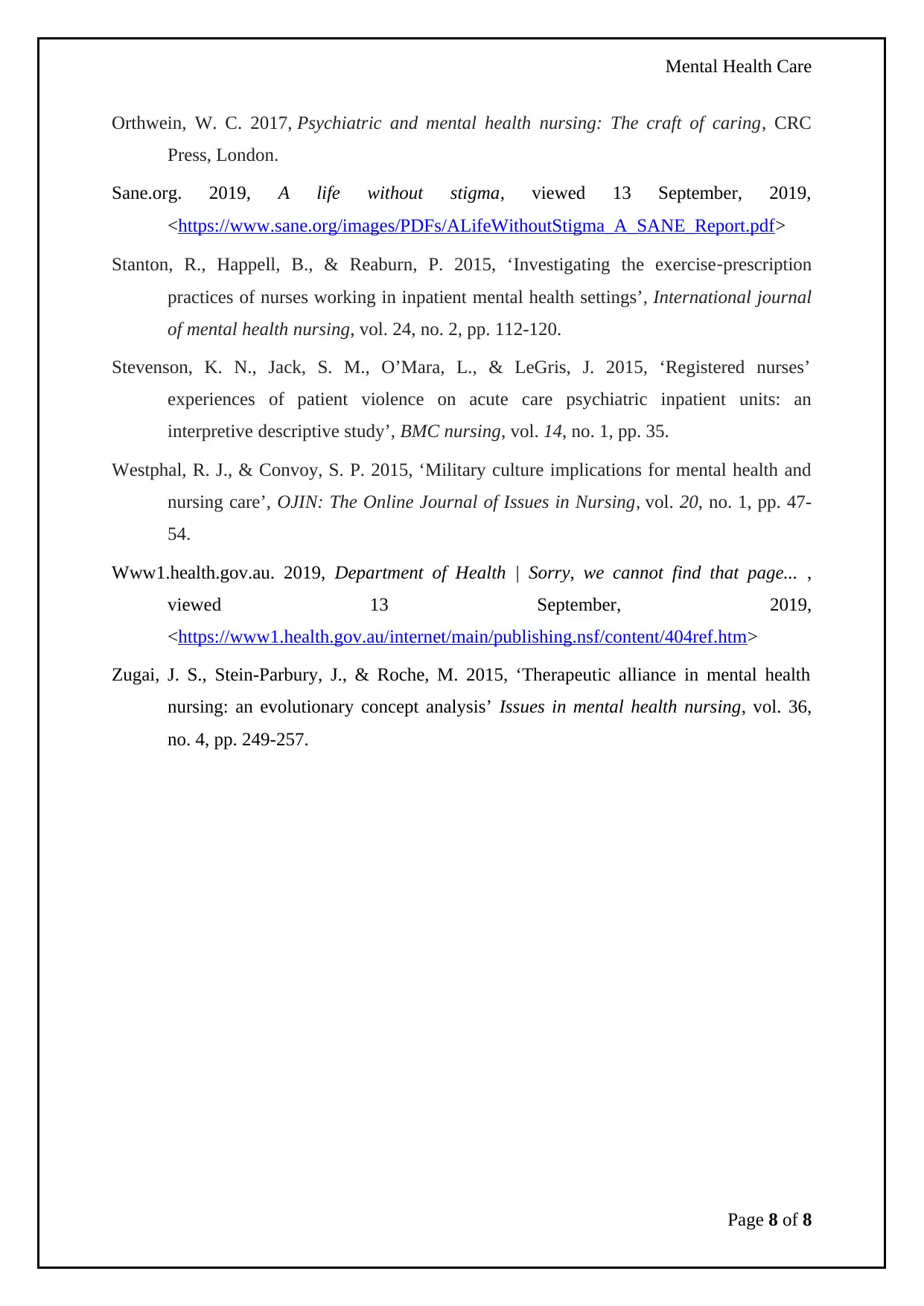
Mental Health Care
Orthwein, W. C. 2017, Psychiatric and mental health nursing: The craft of caring, CRC
Press, London.
Sane.org. 2019, A life without stigma, viewed 13 September, 2019,
<https://www.sane.org/images/PDFs/ALifeWithoutStigma_A_SANE_Report.pdf>
Stanton, R., Happell, B., & Reaburn, P. 2015, ‘Investigating the exercise‐prescription
practices of nurses working in inpatient mental health settings’, International journal
of mental health nursing, vol. 24, no. 2, pp. 112-120.
Stevenson, K. N., Jack, S. M., O’Mara, L., & LeGris, J. 2015, ‘Registered nurses’
experiences of patient violence on acute care psychiatric inpatient units: an
interpretive descriptive study’, BMC nursing, vol. 14, no. 1, pp. 35.
Westphal, R. J., & Convoy, S. P. 2015, ‘Military culture implications for mental health and
nursing care’, OJIN: The Online Journal of Issues in Nursing, vol. 20, no. 1, pp. 47-
54.
Www1.health.gov.au. 2019, Department of Health | Sorry, we cannot find that page... ,
viewed 13 September, 2019,
<https://www1.health.gov.au/internet/main/publishing.nsf/content/404ref.htm>
Zugai, J. S., Stein-Parbury, J., & Roche, M. 2015, ‘Therapeutic alliance in mental health
nursing: an evolutionary concept analysis’ Issues in mental health nursing, vol. 36,
no. 4, pp. 249-257.
Page 8 of 8
Orthwein, W. C. 2017, Psychiatric and mental health nursing: The craft of caring, CRC
Press, London.
Sane.org. 2019, A life without stigma, viewed 13 September, 2019,
<https://www.sane.org/images/PDFs/ALifeWithoutStigma_A_SANE_Report.pdf>
Stanton, R., Happell, B., & Reaburn, P. 2015, ‘Investigating the exercise‐prescription
practices of nurses working in inpatient mental health settings’, International journal
of mental health nursing, vol. 24, no. 2, pp. 112-120.
Stevenson, K. N., Jack, S. M., O’Mara, L., & LeGris, J. 2015, ‘Registered nurses’
experiences of patient violence on acute care psychiatric inpatient units: an
interpretive descriptive study’, BMC nursing, vol. 14, no. 1, pp. 35.
Westphal, R. J., & Convoy, S. P. 2015, ‘Military culture implications for mental health and
nursing care’, OJIN: The Online Journal of Issues in Nursing, vol. 20, no. 1, pp. 47-
54.
Www1.health.gov.au. 2019, Department of Health | Sorry, we cannot find that page... ,
viewed 13 September, 2019,
<https://www1.health.gov.au/internet/main/publishing.nsf/content/404ref.htm>
Zugai, J. S., Stein-Parbury, J., & Roche, M. 2015, ‘Therapeutic alliance in mental health
nursing: an evolutionary concept analysis’ Issues in mental health nursing, vol. 36,
no. 4, pp. 249-257.
Page 8 of 8
1 out of 8
Related Documents
Your All-in-One AI-Powered Toolkit for Academic Success.
+13062052269
info@desklib.com
Available 24*7 on WhatsApp / Email
![[object Object]](/_next/static/media/star-bottom.7253800d.svg)
Unlock your academic potential
Copyright © 2020–2025 A2Z Services. All Rights Reserved. Developed and managed by ZUCOL.





